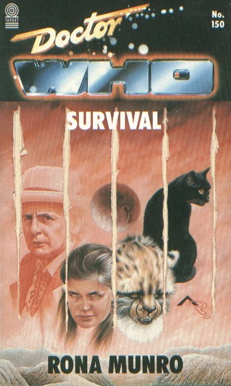
Synopsis: The Doctor brings Ace home to her own time and place. But the time is Sunday and the place is Perivale, the most boring place ever. Most of Ace’s friends have disappeared and the youth club has been taken over by a fanatical army type with a sadistic streak. On a distant planet, the Master waits for the Doctor’s arrival – only with the help of his oldest enemy can he hope to escape a world that is slowly turning him into a ferocious animal…
Chapter Titles: Numbered One to Eight, with a postscript.
Background: Rona Munro adapts her own scripts from the 1989 serial.
Notes: The man who’s abducted while washing his car is called Dave Aitken. His elderly neighbour who shoos away the cats is Mrs Bates. Ace and her gang used to listen to the music of ‘Guns and Roses’ [sic] and ‘Spondy Gee’. There’s a crack on the youth club door that was the result of a fight between Ace and Midge. They all used to hang around outside the local pub hoping they could persuade older kids to buy ‘cans’ for them. The Doctor puts a gold star-shaped coin from Psion B into Ange’s collection tin. Paterson is a police officer, not a sergeant in the territorial army as on TV (hence why he knows Ace was let off with a ‘warning’). After the sergeant criticises her for never phoning home, Ace recalls the events in 1945 that led to her meeting her mother as a baby. Still confused by the conflicting emotions the relationship with he rparents provokes, she feels distressed that the Doctor appears to be ignoring her in favour of his tins of cat food. This prompts her to walk off alone to gather her thoughts – watched by a kitling.
The kitlings (‘feline vultures’) can teleport from planet to planet in search of carrion and have been to Earth many times. They can ‘smell blood even across the vacuum of space’ – and the Cheetah People follow them in search of sport. Midge has posters for heavy metal bands in his room (on TV, he has a U2 album).
Returning home in the early hours of Monday morning, Midge goes to the shop run by Len and Harvey and demands money. The Master releases a kitling in the shop, which transports the shopkeepers away. Midge kills both Paterson and Derek. After Karra is killed, Ace sees Shreela and tells her she won’t be staying in Perivale. Shreela helps her obtain some petrol and Ace lights a pyre for Karra and Midge, before walking off arm in arm with the Doctor (who does not deliver the speech we heard on TV).
Cover: One of the most inventive covers ever, Alister Pearson paints a vista of the Cheetah people’s planet with portraits of a concerned Doctor, a possessed Ace and the Master’s black cat minion. The canvas has been slashed with claw marks. An early pencil draft of this design also showed the Master’s face emerging from the cat’s torso, but this was dropped for the final painting. What’s also rather lovely is that, as the final televised story of the original run, this cover echoes the painting Pearson did for the An Unearthly Child reprint that was publisted just a few months earlier.
Final Analysis: Another cracking novel, it’s largely what we saw on TV but with added violence and a generally more adult tone; as with Ghost Light, it’s beautifully written and visceral. The scene with Ange raising money for hunt saboteurs is enhanced by a shop window containing a dummy wearing a fur coat:
The Doctor pressed closer to the glass. Yellow fur, spotted fur, hung limp and soft on the dummy like the dead thing it was. There was no hint of the long muscles that had animated it, the bone, sinew, heart and lungs of the animal that had worn it as its own skin as it streaked across the dusty yellow savannah, the fastest creature on earth. There was only the barest reminder of the coat’s original owner, the animal that now reminded the Doctor so forcibly of the connection he had been looking for.
With just a couple of novels remaining, the Seventh Doctor era is shaping up to be the most consistent of the Target collection. At the back of this book, in a postscript, range editor Peter Darvill-Evans marked the fact that it appeared unlikely that Doctor Who was returning to our screens any time soon. He also revealed that as well as some remaining novelisations, plans were already underway to start publishing original novels – the continuing adventures of the Doctor and Ace.

One thing that impressed me with this (and I’m a little surprised this doesn’t get a mention in the notes!) is that while it doesn’t include the final speech, Rona Munro have Ace reflecting on the events of Fenric, which was the story broadcast before it, and the revelation that she encountered her mum as a baby. Which I thought was a nice touch.
LikeLiked by 2 people
Good point – I’ll add a line 🙂
LikeLike
I suppose there’s no reason Patterson can’t be both a policeman and a TA sergeant, since the TA is a part-time volunteer reservists’ organisation. Hence the term “weekend warriors”.
LikeLiked by 1 person
Depending on the constabulary, it’s possible, but unlikely to be both a serving officer and in the TA – especially if he’s using the rank of Sergeant. The book makes a little more sense, that he’d been a serving police officer during Ace’s early teens. But it’s posible he’s no longer an officer and has grasped the TA role instead.
LikeLike
The thing I remember from this book (sort of) is a bit of character analysis of the Master that I thought was a really good and creative take on why he behaves as he does. Need to re-read at some point because I don’t remember the actual details at all (having not read the book since it came out when I was 19 or 20); just that I thought at the time, “Yeah, that’s a really good take!”
LikeLiked by 1 person
I don’t have anything to add that hasn’t been said by others already, but speaking of milestones with “Survival” — congratulations on reaching Chapter #150 for ‘Escape to Danger’!
LikeLiked by 1 person
Thanks for sticking with me 🙂
LikeLike